Connect with society and people through music education - Guildhall Connect - No.3
 |
【日本語|English】 【No.1|No.2|No.3|No.4|No.5】 |
No.3 Making our own cool music! 'Urban Sounds'
The main character of the activities of the 'Guildhall Connect' is 'Creativity'. Then what do they actually do in the 'creative' workshops?
Last April, there were two 'Connect' activities in the school holidays at Easter. One was called 'Urban Sounds' and the other was 'World In Motion'. These were both music-making ensemble activities for young people in the community and students at the Guildhall, but, due to their 'creative' character, the outcomes were different depending on the leaders, participants, themes and ideas.
|
- - Activity Information - -
■Title: Urban Sounds
■Dates: 21-22Feb2009, 6-9Apr, 26-28May ■Leader: Paul Griffiths / Sigrun Saevarsdottir ■Target: 10-16 years old ■Fee: Free |
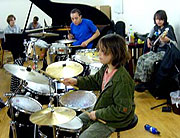
This spring, there were three workshops named 'Urban Sounds'. Young music lovers gather there as a way of spending their school holidays. They can come to all of the workshops or just one or two; it's up to them. There are no auditions, no fees, and anyone can join in. No one knows how many are coming, what kind of instruments will be there in the next ensemble until the first day!
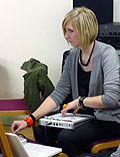
This 4-day activity had an ensemble of about 30 people, with 20 young people aged 9-17 years old, 9 Guildhall students and 2 leaders. The instrumental formation was roughly; 4 violins, 4 flutes, 1 piano, 2 drums, 1 bass, 5 electric guitars, 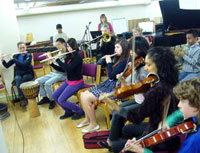 2 percussion instruments, 1 marimba, 1 saxophone, 1 trumpet, 1 horn, 1 trombone, 2 vocals, and 1 computer instrument. There were some who could play the piano but chose to play flute this time, and some changed instruments from bass to marimba, flute or guitar to vocals, according to their interest and the needs of the music as it went on. It was a very flexible and unique ensemble.
2 percussion instruments, 1 marimba, 1 saxophone, 1 trumpet, 1 horn, 1 trombone, 2 vocals, and 1 computer instrument. There were some who could play the piano but chose to play flute this time, and some changed instruments from bass to marimba, flute or guitar to vocals, according to their interest and the needs of the music as it went on. It was a very flexible and unique ensemble.
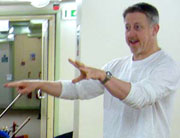
The leaders of 'Urban Sounds' were Paul and Sigrun. They have both completed the master's course in Leadership at the Guildhall and have been very active as workshop leaders in the UK and around the world. They are now veterans, with a career of 22 years for Paul, and 11 years for Sigrun. Paul, who is still active as a performer in rock and jazz bands, leads the ensemble with his guitar on the shoulder, and Sigrun, who learnt trombone, uses it, the piano, jembe and her voice.
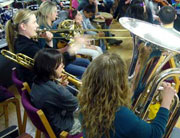 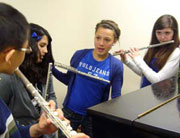 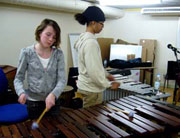
|
'Play 3 notes of your choice.' Paul said to one boy. Although it was a sudden designation, the boy played his 3 notes on the trombone without hesitation. 'Very good! Let's play that together.' 'Next, change one note of them.' 'Strings, can you think of some phrase to answer it?' Like this, ideas from the young people were developed by being transformed and added to little by little. Also, if the children thought that they had a better idea, they could suggest changes about the phrases, notes or rhythm, and were free to do so at any time, even when not invited to do so by the leaders.
In some parts of the music, the leaders nominated someone and said 'This is your solo. Improvise as you like!' and left it to his/her inspiration. In other parts, they divided the young people and students into groups and made them compose 4 bars and bring it back. By being in a small group with similar instruments, even shy children could participate in sharing their ideas with others naturally. Each section was led by one or two students to help the young people to share ideas with each other.
Although it was about the same 4 bars in the same musical movement, the outcomes they brought back varied amazingly. After they listened to each group's composition, they discussed the structure of the music - 'What should be the first and how should it begin?' 'What is the right balance of volume among these instruments here?' - and tried one idea, and if it didn't sound good, tried to find another one. In this way, many phrases changed their form at the end of the day, and a little idea on the first day could turn into a main motive on the last day. So many things that could not have been imagined at the beginning happened in those 4 days.
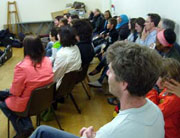
In this project, they will have a big chance to perform their piece at the concert hall in the Barbican Centre with 2000 seats on the 1st July. But, through the workshop, they were focused on composing 'what they want to play now'. The piece they finally created ran for about 30 minutes, with 4 sections. On the last day, they made the intro, ending and the connection part of each section, and performed it for their families.
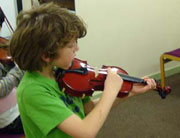
Some people had participated in these projects before, but others came there for the first time. When listening to the cool and exciting music they were creating, it was hard to believe that the music was created by children who were doing it for the first time. But it is possible even for a beginner to do quite a simple thing, such as 'to choose one favourite note and play it' and 'to make your favourite rhythm'. Although it seemed that the music was so long and complicated when looking at the whole musical product, they could create such a wonderful piece just by thinking of some notes and rhythms and combining them along with their partners, without using a score throughout those 4 days.
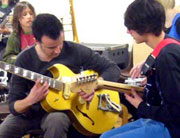
It could not happen if the process of music-making was the one in which they had to memorize and play what they were taught by the leaders. In this workshop, the leaders were one of the performers, who suggested and listened to the ideas, and there were many students and seniors who supported the younger people to understand and catch their ideas whenever they wanted, and this circumstance made it possible for them to create music.
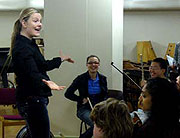
We could feel that the music appeared out of nothing and was developed as if it was a creature growing from just a seed. They were the ones who sowed those seeds and raised them. They played the music which was not forced by the teachers, but was the piece that everyone felt good about. Isn't it a rare and precious opportunity for the teenagers to feel this kind of fulfillment?
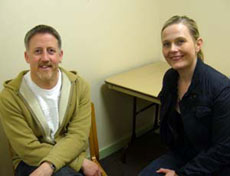
'Ownership - to feel that 'this is my music' - is the most important point of the creative workshop', Paul and Sigrun said. 'We are not only a teacher but also a musician who creates music along with the young people.' 'Through the creative approach, they can be artistically involved in music. That gives them a much higher level of satisfaction, and also we can be always stimulated as musicians by making music with the young people.' They define themselves as 'musicians in education'.
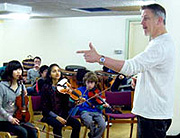
'We cannot have too fixed ideas ahead of the workshop, because we cannot decide what to do next until we see what ideas they suggest. We have to throw out a question to the children, see what comes back, and then make our next decision on the spot. We follow our intuition,' Sigrun said. 'It is not about what I want. It is about what the music wants. If we follow the energy of the music, we can see what the right question to ask next should be,' Paul said. Leaders are required to have these senses.
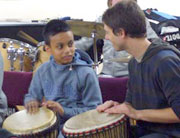
A pianist, Filipe, who is a student on the Leadership course, participated in this workshop and said, 'This is not on the course, but it is a good opportunity for me to learn from Paul and Sigrun, who have a lot of experience. Leading the workshop by myself is of course important, but it is also important to sit with the children and participate just as a performer, because it gives me a lot to learn.' He feels that he 'learned that the most beginner players can play as important role as master players in making music. They can do so much. The major skill of the leader is to work with what the children have and help to turn it into music'.
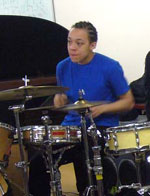
There was 17-year-old Benjiii, who kept coming to almost all the 'Connect' projects since he was 10 years old. He started to join this ensemble playing marimba and vibraphone, and then drums and bass, and is now an apprentice to support the leaders and help the younger children. What made him keep coming? 'This is a wonderful experience. I just come here and make friends, play music with them, and at the end of the day, you'll get a massive piece of music. It is great fun. I like the way the music changes, reflecting the people's feelings.' 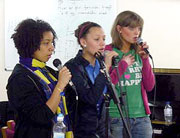 He now also plays in several bands - jazz, reggae, rock, punk - outside of 'Connect'. I asked him what he wanted to do in the future. He replied, 'I want to be a leader like Paul and Sigrun part-time, because I'm still a student. I have a life plan. I want to be a musician or a doctor...or rather, a musician AND a doctor. I cannot stop doing music. I love music, so I cannot give it up.'
He now also plays in several bands - jazz, reggae, rock, punk - outside of 'Connect'. I asked him what he wanted to do in the future. He replied, 'I want to be a leader like Paul and Sigrun part-time, because I'm still a student. I have a life plan. I want to be a musician or a doctor...or rather, a musician AND a doctor. I cannot stop doing music. I love music, so I cannot give it up.'
Next time, we'll see the other workshop with much younger children.
Report: Chigusa Futako







